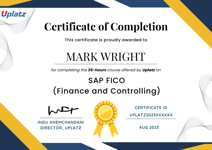- Uplatz Certificate of Completion - Free
Project on Data Visualisation with R
Uplatz
Self-paced videos, Lifetime access, Study material, Certification prep, Technical support, Course Completion Certificate
Summary
Overview
Certificates
Uplatz Certificate of Completion
Digital certificate - Included
Course Completion Certificate by Uplatz
Course media
Description
Learning data visualization using R offers several benefits:
Widespread Adoption: R is one of the most widely used programming languages for statistical computing and data analysis. It has a large and active community of users and contributors, making it a popular choice for data visualization among data scientists, statisticians, and analysts.
Rich Ecosystem of Packages: R has a vast ecosystem of packages specifically designed for data visualization, including ggplot2, plotly, ggvis, leaflet, and more. These packages offer a wide range of functionalities for creating static and interactive visualizations, enabling users to explore and communicate insights effectively.
Flexibility and Customization: R provides a high level of flexibility and customization in data visualization. With packages like ggplot2, users can easily customize every aspect of their plots, including aesthetics, themes, colors, labels, and annotations, to create visually appealing and informative visualizations.
Reproducibility: R facilitates reproducible research and analysis workflows. Visualizations created using R can be scripted and documented in R Markdown documents or Jupyter notebooks, allowing users to generate reports with embedded visualizations, share code, and reproduce analyses easily.
Integration with Data Analysis: R seamlessly integrates with other data analysis tools and libraries, such as the tidyverse ecosystem (which includes dplyr, tidyr, purrr, etc.), statistical modeling libraries (lm, glm, lme4, etc.), and machine learning libraries (caret, randomForest, xgboost, etc.). This integration enables users to seamlessly transition from data manipulation and analysis to visualization within the same environment.
Interactivity: R packages like plotly allow users to create interactive visualizations with features such as zooming, panning, tooltips, and hover effects. Interactive visualizations enhance the user experience and enable deeper exploration of data, making it easier to uncover patterns, trends, and insights.
Career Opportunities: Proficiency in data visualization with R is highly valued in the job market, especially in roles such as data analyst, data scientist, business intelligence analyst, and research scientist. Mastering data visualization with R can open up a wide range of career opportunities in various industries, including healthcare, finance, marketing, and technology.
Community Support and Resources: R has a vibrant community of users, developers, and educators who actively contribute tutorials, documentation, and resources to help learners at all levels. Online forums, user groups, and social media platforms provide valuable support and networking opportunities for R users.
Learning data visualization using R equips individuals with valuable skills for exploring, analyzing, and communicating insights from data, enabling them to make informed decisions and drive impact in their respective fields.
Who is this course for?
Everyone
Requirements
Passion and determination to succeed!
Career path
- Data Visualisation Analyst
- Data Visualisation Developer
- Data Visualisation Engineer
- Data Analyst
- Data Scientist
- Data Engineer
- MI Analyst
- Reporting Analyst
- R Programmer
- BI Developer
- Data & Analytics Professional
- Data Consultant
- Software Engineer
- Software Developer
Questions and answers
Currently there are no Q&As for this course. Be the first to ask a question.
Reviews
Currently there are no reviews for this course. Be the first to leave a review.
Sidebar navigation
Legal information
This course is advertised on Reed.co.uk by the Course Provider, whose terms and conditions apply. Purchases are made directly from the Course Provider, and as such, content and materials are supplied by the Course Provider directly. Reed is acting as agent and not reseller in relation to this course. Reed's only responsibility is to facilitate your payment for the course. It is your responsibility to review and agree to the Course Provider's terms and conditions and satisfy yourself as to the suitability of the course you intend to purchase. Reed will not have any responsibility for the content of the course and/or associated materials.
FAQs
Interest free credit agreements provided by Zopa Bank Limited trading as DivideBuy are not regulated by the Financial Conduct Authority and do not fall under the jurisdiction of the Financial Ombudsman Service. Zopa Bank Limited trading as DivideBuy is authorised by the Prudential Regulation Authority and regulated by the Financial Conduct Authority and the Prudential Regulation Authority, and entered on the Financial Services Register (800542). Zopa Bank Limited (10627575) is incorporated in England & Wales and has its registered office at: 1st Floor, Cottons Centre, Tooley Street, London, SE1 2QG. VAT Number 281765280. DivideBuy's trading address is First Floor, Brunswick Court, Brunswick Street, Newcastle-under-Lyme, ST5 1HH. © Zopa Bank Limited 2026. All rights reserved.

